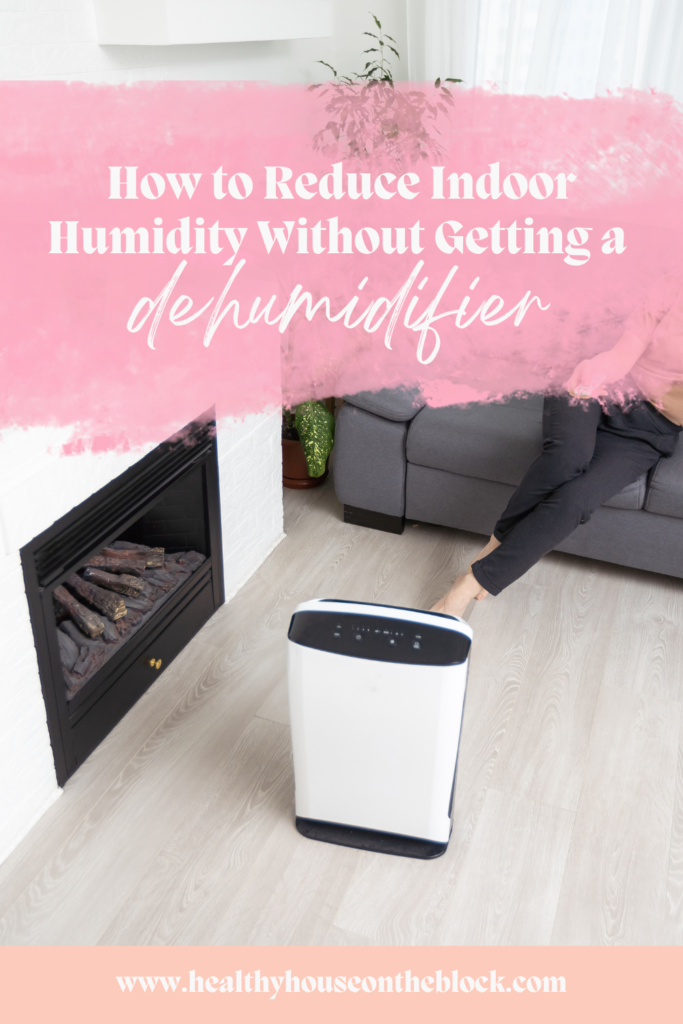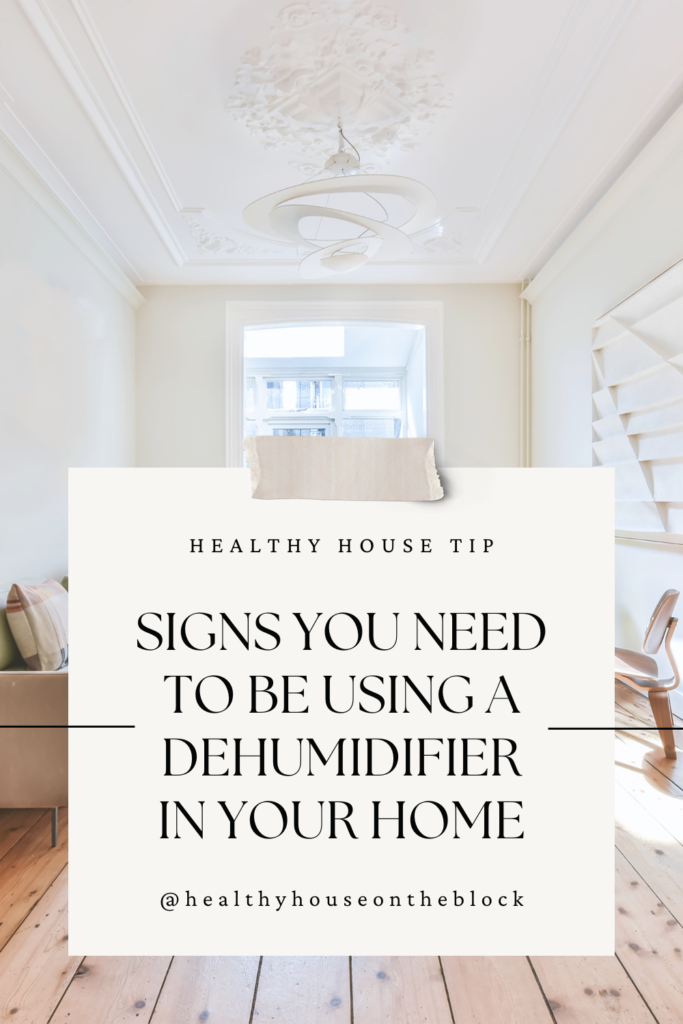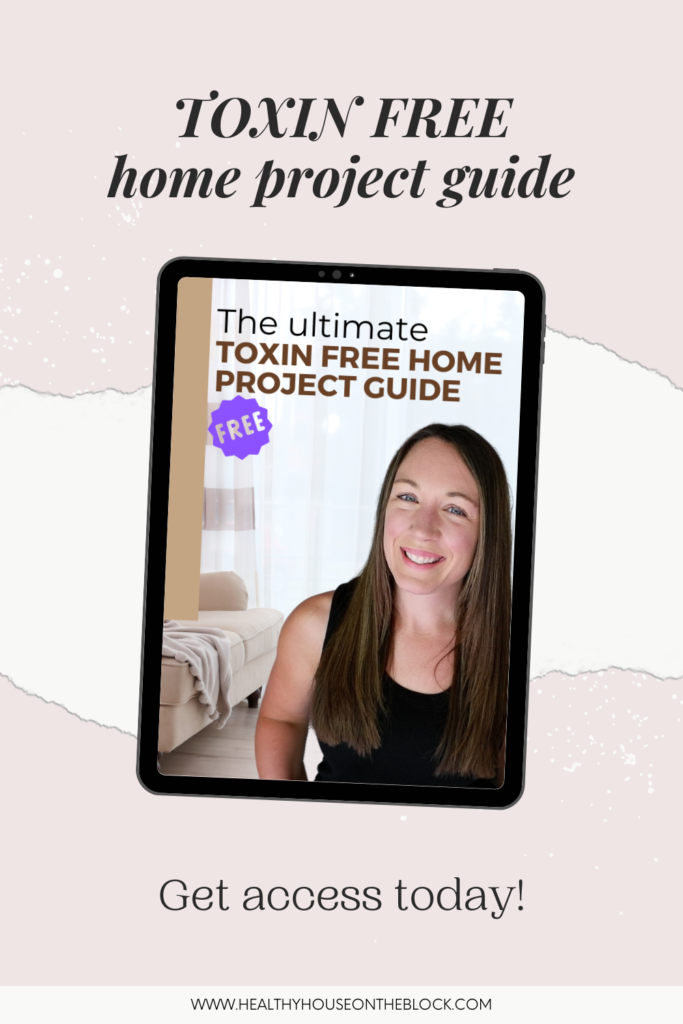
Did you know that the climate inside your home plays a HUGE role in the overall health of your space? And in particular, the indoor humidity levels inside, or the relative humidity in your home is a key metric to know about your space.
One of the biggest mistakes I see otherwise health conscious families making is totally ignoring the climate inside and focusing only on products and materials. But this thinking is a little backwards. Our products and materials in our home behave differently, off-gassing more or less, depending on the climate we have in our home.
Imagine that all you had to do was adjust some of your habits indoors to drastically improve your indoor air quality in your home. That’s exactly the big, impactful change we’re working towards. Why not improve your space in a big way with the smallest amount of effort?
Most every home deals with high levels of humidity at some time. These ideas will help you figure out how to maintain the perfect indoor humidity levels for your home.
INDOOR HUMIDITY LEVELS MATTER TO THE HEALTH OF YOUR HOME
Whether you have allergies or not, I think we can agree that dust mites and mold are two things we generally don’t want inside our homes.
An increasing number of dust mites will occur as they will reproduce more quickly in high levels of humidity. This means if you have just a few dust mites on some stuffed animals or textiles, they will begin to multiply when the indoor humidity levels are above 50% – 60%. (SOURCE)
An even bigger area of concern is high indoor humidity levels promote the growth of mold and fungi in your space. As a certified mold tester, I see increased mold spores in homes ALL the time. And areas that typically have the HIGHEST levels are rooms where the humidity levels are the highest. Oftentimes bathrooms and below grade basements have the most alarming counts of mold spores. What we know with an air test is that these high humidity rooms correlate with more mold spores in the air that we breathe as well.
If you thought we could just stop at these two natural contaminants, think again. Volatile Organic Compounds (VOCs), especially formaldehyde — which we all have in our homes — off gas at higher rates as the indoor humidity levels increase. As these chemicals react with the water vapor, they release higher and higher levels of VOCs into the air from your building materials, carpet, furniture and textiles. (SOURCE)
In general, homes with damp environments, or higher levels of relative humidity, correlate with respiratory disorders such as asthma, chronic sinusitis, chronically inflamed lungs and respiratory symptoms like coughing and wheezing. (SOURCE)
In addition to all of this, the higher your humidity levels inside, the less your thermal resistance is on your home, or the less energy efficient your structure is too. (SOURCE)
HOW TO ASSESS YOUR INDOOR HUMIDITY LEVELS

When you’re inside your home, it can be really difficult to know if you have high humidity levels. Indoor humidity levels can also fluctuate from season to season as well as from room to room in your home.
Most homes have rooms that are much higher in relative humidity than other rooms. And depending on where you live, and the season you’re in, you may have high humidity levels at some times and too low humidity levels at other times.
A simple hygrometer is key to knowing what your humidity levels are, and I highly recommend having this tool in your own home. You can often move these from room to room and assess what needs to happen in each space.
The ideal humidity level for a home is between 35% – 40%. Anything lower and you’ll feel incredibly uncomfortable; and any higher, you’ll increase your chances of mold growth, dust mites and increase the rates at which VOCs off gas.
WAYS TO REDUCE INDOOR HUMIDITY LEVELS BEFORE GETTING A DEHUMIDIFIER
Some homes won’t actually need a dehumidifier. In fact, there are some really quick and easy habit changes and minor maintenance items that you can try BEFORE getting a dehumidifier.
Use Vented Fans Consistently: Whenever you’re in a space that HAS a vented space and you’re producing moisture in that area, be sure to run that vented fan as much as possible. It’s also worth mentioning that you may need to upgrade your vented fan if it’s old and not as powerful.
My general rule is to run the vented fan in the bathroom, laundry or kitchen while you’re using the space and then for about 20 minutes afterwards. This will help pull out as much moisture as possible, leaving you with an indoor humidity that isn’t too high.
Check the Exterior for Moisture Prone Areas: Make sure that you don’t have sprinklers pointed at your siding or foundation walls, first of all. Then make sure you’re not overwatering your lawn or garden areas that are near your structure.
It’s also a good idea to check your grading and make sure all the soil is angled away from your home, like a little hill. And then finally, check your gutters to make sure they aren’t filled with debris.
Don’t Overwater Plants: All that water can not only just sit in the plant soil, but it will also evaporate, causing the humidity levels in your home to rise. It can also be a spot that mold can start due to the substrate of the plant and soil.
Avoid Line Drying Laundry Indoors: Line drying is excellent, when it’s outdoors. Be very cautious bringing your laundry indoors to dry. Large amounts of wet laundry will evaporate indoors, causing high levels of humidity in that space.
Cook with Lids: If you can manage to cook with your lids on, you can actually prevent a huge source of indoor humidity. While this isn’t possible all the time, it can be something you do now and then. If nothing else, use those vented fans in the kitchen to draw out the moisture in the air.
Wipe Down Condensation & Wet Areas Regularly: Areas that have a lot of condensation (maybe windows or doors in particular months) should get wiped down consistently. By removing the condensation, you’re avoiding the process of evaporation, where it raises your indoor humidity levels. It also helps to keep shades open when possible to avoid trapping the moisture on the window or window sill.
You can also squeegee or wipe down shower and bathroom walls as necessary. We may not do it after every shower, but when showers are done for the morning or evening, we try to remove as much water from the bathroom as possible with a dry towel or squeegee. Again, this just helps keep those indoor humidity levels in check.

SIGNS YOU NEED A DEHUMIDIFIER
If all of the changes above didn’t help reduce your indoor humidity levels, then it may be time to consider a dehumidifier to help keep levels low and remove moisture from the air in your home.
Musty Smell: If particular areas of your home have a constant musty smell that you just can’t pinpoint or get rid of, it may be time to reduce moisture in a bigger way with a dehumidifier. This is most often the case in basements and crawl spaces, but it can happen anywhere depending on your climate and home layout. Don’t try to cover up those musty smells, instead try to get them at the source and reduce indoor humidity levels as much as you can to get rid of it.
High Hygrometer Reading: The number one tell-tale sign that you need a dehumidifier in a particular area of your home is if you’ve had a hygrometer reading that is above 50% – 60% consistently. The hygrometer reading is one of the best tools you can utilize when you’re trying to fix your indoor air climate. It’s like using a thermometer when you’re not feeling well to tell you if you do in fact have a fever. It’s a more clear-cut way of figuring things out in your home.
Inconsistent Seasons: Depending on where you live and what your climate is, you may need a dehumidifier in some seasons, and not in others. This is completely normal. Usually, summer months (if you’re in North America) are particularly hot and humid, while winters can be cold and dry. If this is the case in your home, you may need a dehumidifier only for spring and fall, when your HVAC is in between heating and cooling. If your seasons are wildly inconsistent and vary greatly, it’s a great option to have in your back pocket.
Evidence of Mold Growth: When you’re in your bathroom, laundry or basement, do you feel like you’re constantly trying to get rid of mold and mildew? If it’s a problem that just doesn’t seem to go away and it’s a constant battle to get it cleaned up, it’s a good sign that you may need to increase ventilation and reduce indoor humidity levels on a grander scale. Bringing in a dehumidifier will help the space dry out quickly, leaving little room for mold and mildew growth.

HEALTHY HOUSE APPROVED DEHUMIDIFIERS
Midea Cube: This is the one we use in our home (without Wi-Fi). It’s been going for years with a drain hose and requires very little maintenance from us. It does a great job of reducing moisture in our humid basement all summer long. This is for bigger areas like entire basements or crawl spaces.
Frigidaire: Perfect for medium to large spaces when you’re dehumidifying your space. This one has a super easy-to clean, washable filter to keep all the gross stuff from breeding mold and mildew. You can also attach a hose, or empty the basin, which is great for larger areas.
EvaDry: I love that this one has a transparent, removable water tank so you can clean it out when you dump the water out. This one is fairly small and is good for closets, bathrooms and bedrooms.
PureDry: If you need to dry out a small space without a big and bulky dehumidifier, this is your best bet. I love that this one is compact and slender so you can place it wherever you need in bathrooms, closets and other small spaces.

Whether you need a dehumidifier all the time or year round, this is one of my FAVORITE tools in creating a healthy home. Your indoor humidity levels are extremely important to not only your health, but the health of your home in the long run.




